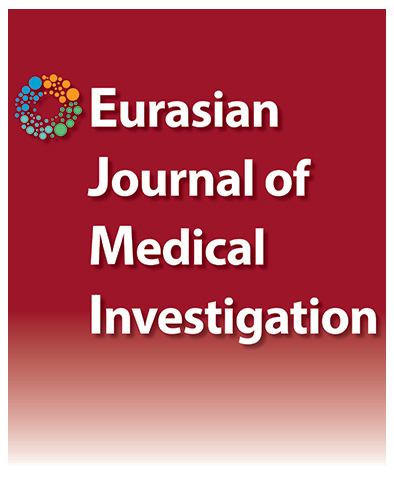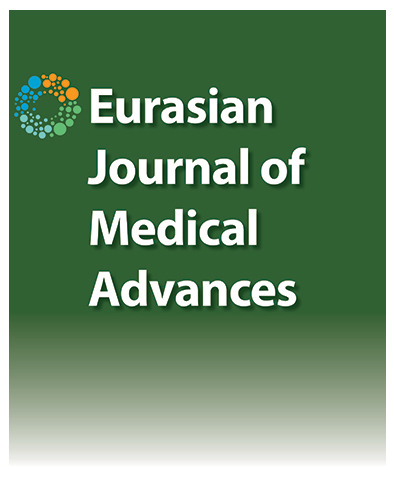Volume: 4 Issue: 1 - 2024
| RESEARCH ARTICLE | |
| 1. | The Impact of Serum Uric Acid Level on Progression of Chronic Kidney Disease in Non-Diabetic Patients: A Retrospective Analysis Ezgi Çoban, Izzet Hakkı Arıkan doi: 10.14744/ejma.2024.09326 Pages 1 - 7 Objectives: Hyperuricemia is common in CKD patients. This retrospective study aimed to investigate the relationship between serum uric acid and the progression of CKD in stage 2 and 3 non-diabetic patients with CKD. Methods: The study sample included non-diabetic patients with stage 2 and 3 CKD, aged between 30 and 90 years, who were on nephrology follow-up for more than a year at our hospital. Serum uric acid levels recorded at presentation were considered baseline uric acid levels and annual eGFR, was calculated based on MDRD whereas BUN and blood creatinine values measured during patient visits were recorded retrospectively, as annual mean values. Results: 71 patients were included. Annual reductions in eGFR were significantly higher in male patients (3.8±4.7 ml/min/1.73 m²) compared to female patients (1.7±2.3 ml/min/1.73 m²) (p<0.032). In a multivariate linear regression analysis, the variables associated with annual reductions in eGFR measurements were baseline serum albumin level, baseline eGFR, and annual mean uric acid levels. No statistically significant differences were found between patients with hyperuricemia (n: 49) and patients without hyperuricemia (n: 22) in annual eGFR decline (2.9±4.5 vs. 2.0±2.71 ml/min/1.73 m², respectively; p=0.894) and annual eGFR decline in patients treated with allopurinol was comparable to those in patients who were not treated with allopurinol (2.2±2.4 vs. 3.2±4.3 ml/min/1.73 m², p=0.323; respectively). Conclusion: We couldn’t find any significant association between baseline serum uric acid levels and declines in eGFR. This finding reinforces the notion that hyperuricemia may arise from declining eGFR rather than accelerating CKD progression. |
| 2. | Von Hippel-Lindau Disease: The Importance of Early Diagnosis and Treatment Hüseyin Erdem Ak doi: 10.14744/ejma.2024.49469 Pages 8 - 12 Objectives: To provide an overview of Von Hippel-Lindau (VHL) disease, including its clinical presentation, treatment modalities, and follow-up protocols. To present a detailed analysis of patients within a family affected by VHL disease. To investigate challenges encountered in the treatment and follow-up of VHL disease, along with the optimal timing for treatment. Methods: Diagnosis of patients was established through clinical examination, contrast-enhanced magnetic resonance imaging (MRI), and genetic testing. Surgical excision, radiotherapy, and chemotherapy were administered based on tumor localization, number, and size of lesions. Results: VHL disease necessitates lifelong regular monitoring and treatment due to its chronic nature. Early diagnosis and planning for Gamma Knife treatment have been observed to lead to increased lifespan and improved quality of life for patients. Conclusion: Early diagnosis and routine follow-up are crucial in managing VHL disease effectively. Multi-disciplinary approaches, including surgical intervention, radiotherapy, and chemotherapy, are essential in the treatment of VHL disease. Lifelong monitoring and treatment are necessary to optimize outcomes and improve the quality of life for individuals with VHL disease. |
| 3. | The Effect of Respiratory Exercises on People with Ongoing Dyspnea and Recovered from COVID-19 Şerife Çetin, Murat Çetin, Ali Kaplan, Özlem Kaplan, İlhami Çelik doi: 10.14744/ejma.2023.29491 Pages 13 - 21 Objectives: Dyspnea is the most common symptom after having coronavirus disease 2019 (COVID-19). In this study, we evaluated the effect of respiratory exercises on dyspnea in the post-acute period in people who recovered from COVID-19 disease but continued to have dyspnea. Methods: This research was a randomized controlled, single-blind experimental study. Research data were collected between October 1, 2020 and January 31, 2021, and a total of 50 patients, 24 intervention and 26 control groups, were included in the study. The intervention group received diaphragmatic and lip-contraction breathing exercises for 10 minutes twice a day for a month, while the control group did not receive any exercise in addition to standard treatment. Dyspnea-12 (D-12) and the Numerical Rating Scale (NRS) were used as outcome measurement tools. Results: There was no difference between initial D-12 and NRS scores in the intervention and control groups, and the groups were normally distributed. After the application, the D-12 and NRS Scale scores of the intervention group were significantly lower than those of the control group (p<0.05). Moreover, the last measurements of the intervention group were significantly lower than the D-12and NRS scores than the initial measurements (p<0.05). Conclusion: According to the results obtained, diaphragmatic and pursed lip breathing exercises are effective on postrecovery dyspnea in COVID-19 patients. |
| 4. | The Association of Mismatch-Repair (MMR) Deficiency with Tumor Infiltrating Lymphocytes and Survival in Patients with Ovarian Cancer Burcu Yapar Taşköylü, Ferda Bir, Atike Gökçen Demiray, Serkan Değirmencioğlu, Gamze Gököz Doğu, Arzu Yaren, Ahmet Ergin, Canan Karan, Burçin Çakan Demirel, Tolga Doğan, Melek Özdemir, Taliha Güçlü Kantar doi: 10.14744/ejma.2023.74946 Pages 22 - 27 Objectives: The role of DNA mismatch repair (MMR) deficiency in the pathogenesis and prognosis of ovarian cancer has been a subject of considerable research. Deficiency in MMR genes result in accumulation of thousands of mutations in the genome, leading to a high mutation burden and subsequent activation of the immune system due to an increase in the number of “mutation-derived neoantigens”. It has been increasingly reported that this process results in the number of tumors infiltrating lymphocytes with a favorable impact on prognosis. The aim here is to examine the association of mismatch repair (MMR) deficiency with tumor-infiltrating lymphocytes and other clinical and pathological characteristics in patients with ovarian cancer. Methods: In a total of 81 patients with ovarian cancer, the microsatellite instability and presence of tumor infiltrating lymphocytes (CD3, CD8, CD4) were examined immunohistochemically. Negative test result in any of the markers MLH-1, MSH-2, MSH-6, or PMS-2 was considered to microsatellite instability (MSI). Also, with regard to tumor infiltrating lymphocytes, a proportion level of greater than 10% was considered positive. Results: Fifty-one patient (53%) had locally advanced and metastatic disease, and 54 patients (66.7%) had high-grade tumors. Fifty-nine patients (72 %) had serous carcinoma. There was a loss of MMR protein expression in 28 patients (35%), and 53 (65%) were microsatellite stable. There were no significant associations between microsatellite status and age, grade, stage, lymphovascular invasion, CD3, and CD8. Among microsatellite stable patients, CD4 was statistically significantly higher (p=0.03). A reduction in CD3, CD8, and CD4 was found in 53 (64%), 57 (70%), and 54 (66 %) patients, respectively. A significant association between CD3 and lymphovascular invasion was found (p=0.011). CD3 levels are higher in patients with lymphovascular invasion. Survival analysis did not show any relationship between microsatellite instability, progression-free survival, and overall survival. Stage, grade, lymphovascular invasion, Ki-67, and CD8 were significant predictors of progression-free survival (p<0.001, p=0.011, p=0.022, and p=0.02, respectively). Also, there was a significant association between CD4 and overall survival (p=0.007). Conclusion: We believe that assessment of tumor infiltrating lymphocytes holds the potential to provide valuable prognostic information as well as guidance for management strategies in the clinical practice. |
| 5. | The Predictive Value of Urinary HMGB1 Level in the Diagnosis and Prognosis of Renal Cell Carcinoma Mehmet Solakhan, Necla Benlier, Osman Barut, Hülya Çiçek, Özlem Nuray Sever, Mustafa Yıldırım doi: 10.14744/ejma.2024.93063 Pages 28 - 33 Objectives: To investigate the diagnostic and prognostic value of HMGB1 when used as a urinary biomarker in patients with renal cell carcinoma. Methods: The study was conducted in a total of 99 participants including 34 patients diagnosed with Renal cell carcinoma [RCC], 34 patients with an acute urinary tract infection [UTI] and 31 healthy controls.Urinary HMGB1 levels of the study groups were evaluated. Urinary HMGB1 levels and tumor diameter among patients with different subtypes of renal cell carcinoma were comparison. Results: Urinary HMGB1 levels differed significantly among the three groups [p<0.001]. Pairwise comparisons revealed statistically significant differences between RCC and UTI groups [p<0.001] and between RCC and control groups [p<0.001]. No significant difference was detected between acute UT In and control groups [ p=0.078]. Urinary HMGB1 levels were significantly different when compared among RCC subgroups, [ p=0.035], with a much higher median value [499,9 pg/mL] in the sarcomatoid type in particular. The tumor diameter also significantly differed among patients with different types of RCC [p=0.002]. Specifically, a much greater tumor diameter was found in patients with the sarcomatoid type. The cut-off values derived from the ROC analysis were 104.85 pg/mL for distinguishing RCC from a UTI, 35.15 pg/mL for acute UTI versus controls, and 87.55 pg/mL for RCC versus. Sensitivity 79%, specificity was found 85%. Conclusion: Urinary HMGB1 levels as measured by a non-invasive method in the present study were higher in renal cell carcinoma and closely associated with high-grade tumor. |
| 6. | The Association Between Albumin Level and Mortality in Patients Hospitalised in Internal Medicine Clinic, Large Patient Population Ali Kaan Güren, Refik Demirtunç doi: 10.14744/ejma.2024.69775 Pages 34 - 38 Objectives: Albumin, an essential structural protein, performs numerous critical functions throughout the body. Its serum level is low in several disorders that decrease production and increase consumption and loss. We investigated the relationship between serum albumin (SA) levels measured within 24 hours of hospitalization and in-hospital mortality, duration, and recurrent hospitalizations within one year in all Internal Medicine clinic patients, regardless of diagnosis or comorbidities. Methods: The data of the patients were recorded retrospectively. Patients were divided into 4 groups according to SA level as severe hypoalbunemia (< 2.5 g/dl), mild hypoalbunemia (2.5-3.5 g/dl), normal albumin (3.5-4.5 g/dl) and hyperalbunemia (>4.5 g/dl). In-hospital mortality, duration of hospitalisation, recurrent hospitalisation and time to mortality were compared between the groups. Results: A total of 2164 patients, 51% of whom were female, aged 66.15±18.05 years, participated in the study. Among the patients, 220 (10.2%) had severe hypoalbuminemia (Group 1), 1054 (48.7%) had mild hypoalbuminemia (Group 2), 863 (39.9%) had normal albumin (Group 3) and 27 (1.2%) had hyperabuminemia (Group 4). In-hospital mortality rate was 41.4% in Group 1, 12.9% in Group 2, 3.1% in Group 3 and 0% in Group 4 (p<0.001; p<0.05). Median hospital stay was 4 days in hyperalbuminemia group, 6 days in normoalbuminemia group, 8 days in mild albuminemia group and 12 days in severe hypoalbuminemia group (p<0.001; p<0.05). Conclusion: Hypoalbuminaemia increased in-hospital mortality and poor prognosis in Internal Medicine clinic patients. Serum albumin levels predict in-hospital mortality, length of stay, and repeat hospitalizations independently. |
| 7. | Evaluation of the Most Cited Articles on Strabismus From a New Perspective Using Bibliometric Analysis Erkan Bulut, Emel Başar, Sümeyra Köprübaşı, Mehmet Dokur doi: 10.14744/ejma.2024.57070 Pages 39 - 47 Objectives: Strabismus is one of the important areas of interest for ophthalmologists, because it can result in permanent vision loss and reduced binocular function. In this bibliometric study, we aimed to contribute to scientists in their research in the field of strabismus by performing multidimensional citation analysis and visualization of the 100 most cited articles regarding strabismus. Methods: We used the term "strabismus" to search the Thomson Reuters' Web of Science database between 1975 and 2021 years. The top 100 cited articles were analysed by topic, first author, study type, level of evidence, period since publication, journal name, journal impact factor and H-index, total citation number (TCN), average citation per year (ACpY) and also correlation analyses were performed. The SPSS® 23.0 software package was used for all statistical analysis. VOSViewer software was used for visualization and analyses of country, organization, and keyword data of the top 100 cited articles. Results: A total of 6,582 strabismus-related publications were retrieved, and the 100 most-cited were identified. The median values for journal impact factor, H-index, period since publication, TCN, and ACpY were 4.68±2.65 (4,10), 160.29±75.53 (186), 22.17±8.92 (21), 77.98±55.88 (63), and 3.90±2.94 (2,84), respectively. Most of the articles were published between 1990 and 2010 years. The majority of articles were about treatment (n=30), epidemiology (n=21), quality of life and psychosocial aspects (n=14), and strabismus types and clinical features (n=12). The journal with the most articles published, "Ophthalmology," had 25 articles. Interestingly, the correlation analysis demonstrated no association between TCN and IF. Conclusion: Most of the highly cited papers in the topic of strabismus are on strabismus treatment, particularly botulinum toxin treatment. Strabismus articles published in general ophthalmology journals received higher citations. |
| 8. | Factors Effective in Persistent Penicillin Allergy Şafak Yıldırım Dişli, Adile Berna Dursun doi: 10.14744/ejma.2024.39306 Pages 48 - 54 Objectives: The present study investigates the factors effective in the continued sensitivity to penicillin of people with penicillin allergies. Methods: Included in the study were patients who presented with penicillin allergies and defined penicillin allergies between July 1, 2013 and December 31, 2015. The sample was divided into two groups, being: those with continued sensitivity, and those with a previous history of allergy to the group of drugs who can now use them without problems after undergoing diagnostic tests performed following the National Guidelines for Approach to Clinical Drug Hypersensitivity to those with suspected penicillin allergy, and these two groups of patients were compared. 14, 2 and 4. Results: Among 70 patients with penicillin allergies, 14 were excluded due to irrelevant histories or incomplete tests. Among those with complete test results (n=36), 17 (47%) showed no persistent allergy, while 13 (36%) had persistent allergies via skin tests, and 6 (17%) via oral provocation tests after negative skin results. Persistent allergies typically developed within 5 years of initial reaction, ceasing after 7 years. Conclusion: Allergic evaluations should be made based on detailed patient histories, skin tests and oral provocation tests so as not to limit the use of penicillin unnecessarily in those with a history of penicillin allergy lasting longer than 5 years. |
| 9. | Retrospective Evaluation of Patients with Toxic Liver Disease and Fungal Intoxication: A University Hospital Experience Muzaffer Uğraklı, Ali Demir doi: 10.14744/ejma.2024.58070 Pages 55 - 64 Objectives: The liver has an important place in toxin and drug metabolism. However, the diagnosis of liver damage due to chemicals, fungi, herbal toxins and drugs can rarely be detected. In our study, it was aimed to retrospectively evaluate the laboratory values, liver biopsy, treatment, mortality and morbidity rates of patients diagnosed with mushroom poisoning or toxic liver disease. Methods: The data of 303 patients diagnosed with fungal intoxication or toxic liver disease, who admitted to Departments of Internal Diseases and Gastroenterology of Necmettin Erbakan University Faculty of Medicine between 2006 and 2016, were evaluated retrospectively by using the hospital automation system. The treatments applied to the patients, pathology results, laboratory results and mortality rates were analyzed. Results: Of the patients; 52.5% (n=159) were female and 47.5% (n=144) were male. The average age of the patients was 50.9±19.7 years. Drugs were the most common cause of toxic hepatitis cases (48.8%), other causes were followed by fungi, herbal medicines, unknown cases and narcotic toxins (20.8%, 18.8%, 8.6%, 3.0% respectively).Drugs causing toxic hepatitis were most commonly NSAIDs (31.1%), followed by antibiotics, antiepileptics, antituberculosis drugs and paracetamol (21.6%, 6.8%, 6.8%, 6,1%, respectively). In histopathological examination, 92.9% of the cases had liver necrosis, 60.7% eosinophilia, 67.9% hydropic liver degeneration, and 28.6% bile obstruction. In addition to supportive treatments during the therapeutic process, plasmapheresis was applied in 13.2% of the patients and hemodialysis was applied in 13.2%, while liver transplantation was performed in 2.3% of the patients due to a fulminant course. While 20 patients died for various reasons, the overall mortality rate was calculated as 6.3%. The mean age of the deceased patients was 66.5±16.8 years and the mean age of the survivors was 49.9±19.5 years, and that of deceased patients was statistically significantly higher (p<0.001). The mortality rate was 9.0% in men and 3.8% in women, with no statistically significant difference (p=0.060). Histopathological findings were not associated with mortality. The mortality rate in toxic hepatitis was caused by mushroom, narcotics, drugs, herbs and unknown causes (12.7%, 11.1%, 4.7%, 3.5% and 3.8%, respectively). Conclusion: Toxic hepatitis is a common health problem that can result in serious morbidity and mortality. In this thesis study, various drugs, mushroom poisoning and use of herbal medicines were determined as the causes in most of the toxic hepatitis cases diagnosed in our hospital. Based on these findings, we believe that in order to prevent toxic hepatitis cases in our country, it would be beneficial to take measures to prevent unnecessary use of drugs and herbal products, to regulate the marketing and usage conditions of herbal products and to carry out studies to inform the public about this issue. |






